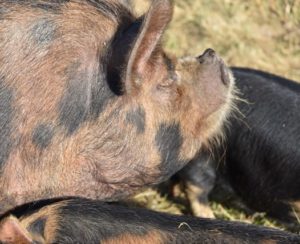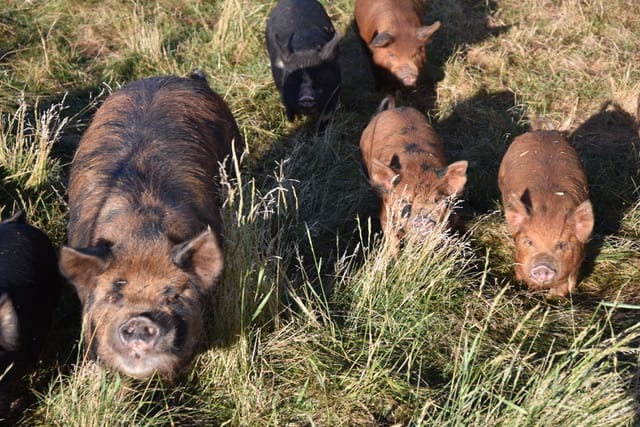Exploring Kunekune Pigs
This blog is a supplement to “the Practical Farmer” magazine article, Pig Portraits.
After years of life captaining ships at sea, Kevin Martin and his wife, Kendra, traded the rolling waves for rolling hills of grass at their farm near Mount Ayr, Iowa. This topography is what they felt made Kunkune pigs ideal for their farm.
“The way they’re bred is that their noses are really upturned, so generally speaking they don’t root,” Kevin says. “We didn’t want anything rooting because our ground is steep, and we’re working with some special erosion control systems that we didn’t want pigs messing with.”
The lack of rooting isn’t the only thing that made the Kunekune perfect for the Martins. It’s their unique ability, requirement really, to have a grass-based diet. “Most people, if they’re doing the grass-fed pork thing, the pigs just have vegetation available to them, they’re not thriving on exclusively grass. They need a lot of extra feed to supplement. Kunekunes are bred to thrive on grass. If you give them anything else they’ll just get way too fat. It causes problems for farrowing and the meat suffers.”
Requiring only grass makes them a very low input pig, but even so, Kevin says it would be very difficult to be profitable in meat production. They’re so slow growing. It takes 18 months to get to butchering weight, and even then, they top out at 200 pounds. “It’s hard to see the viability unless you can do charcuterie and sell to super high end markets.“ So instead, they sold exclusively live animals to folks who wanted either a pet or homesteaders looking for a small pig for their own meat.
“When I sold to other people I gave them warnings: ‘Be careful what you’re getting into. It’s intense!’” Kevin says he understands the allure but advises doing a lot research to understand what you’re getting into. If you decide to pull the trigger, grow slowly. At 6-12 piglets in a litter, the populations can grow fast if you decide it’s what you want, so just ramp into it gently. Get one or two and go through a farrowing season to see how that goes. “It’s not just roses and rainbows. It’s gonna get gnarly.”
While selling the pigs was always profitable, the learning curve for farrowing and the infrastructure needs of pigs proved to be more trouble than expected. Inspired by conversations at the PFI annual conference, the Martins decided to pare back their enterprises and invest their time and energy in other areas of the farm. “Our farm is pretty well set up to expand our goats with less infrastructure than the pigs.” Their breed of choice, the Kiko, just happens to be a New Zealand transplant like the Kunekune.



